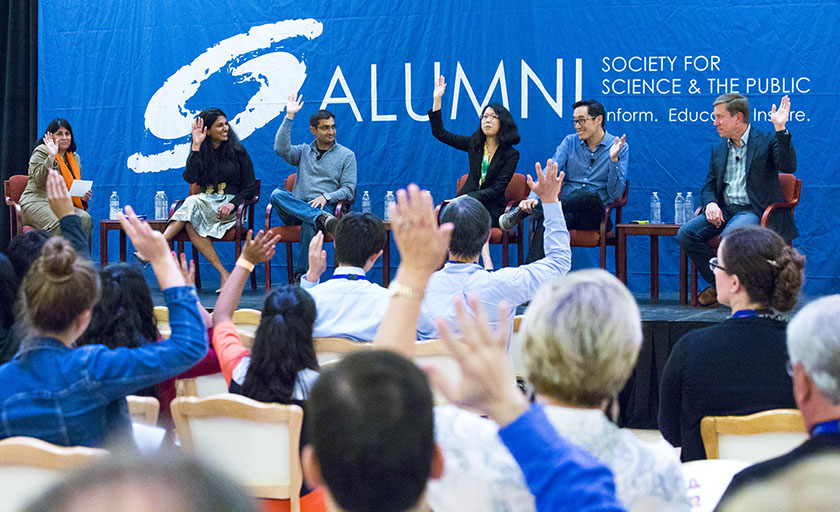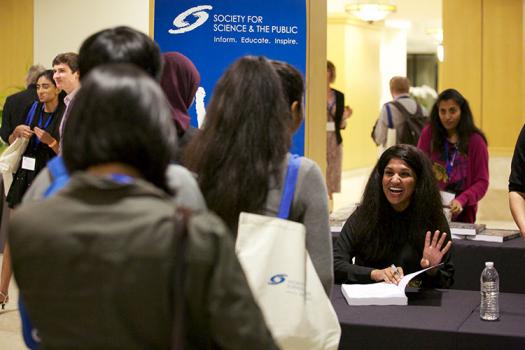Science fairs: Opportunity to make a deep impact

Of all the many lessons learned through participating in Society for Science & the Public’s competitions, alumni often say they’re most thankful they learned how to communicate science effectively, how to carry an idea from inception to the final product, and how to become self-reliant.
Over 100 Society alumni gathered at Stanford University’s Frances C. Arrillaga Alumni Center on November 7, 2016 for an evening of socializing and lively conversation with a panel of distinguished alumni from across the Bay Area. Society President & CEO Maya Ajmera and Stanford President Dr. Marc Tessier-Lavigne welcomed guests at an opening reception.
Meet the Panel
- Maya Ajmera (moderator), Society for Science & the Public, 1985 STS
- William Bencze, Apple, 1985 STS and 1984 ISEF
- Benjamin Jun, HVF labs, 1992 STS
- Meredith Lee, West Big Data Innovation Hub, 2000 STS and 2000 ISEF
- Rajen Sheth, Google, 1994 STS and 1992-1994 ISEF
- Nina Vasan, Stanford Psychiatry Innovation Lab, 2002 STS and 2002 ISEF
“The Society is a special organization for me,” Tessier-Lavigne shared. “Not only because the Science Talent Search provided a wonderful learning experience for [my daughter] Ella [STS 2016 semifinalist], but also because so many students and alumni of Stanford are also alumni of Society’s programs. There is a real connection between our two institutions. We both value STEM education, and are working to prepare young people for meaningful careers in those areas.”
During the panel discussion, Maya Ajmera asked the panelists to recount some of their memories from the Society’s competitions, including the Regeneron Science Talent Search, Intel International Science & Engineering Fair, and Broadcom MASTERS. They also discussed their paths to success and where they saw the STEM fields heading.
Be a champion for strong science. Join the Society now.
For alum William Bencze, the Society’s science fairs were about learning to think on his feet.
When his project — a parallel processing computer — broke after arriving at the competition, Bencze took a trip to Radio Shack and, after wracking his brain, was able to rebuild the machine. In the end, the judges were more impressed with his ability to repair the computer than what it could do.
“The Society is a special organization for me … We both value STEM education, and are working to prepare young people for meaningful careers.”
Alumna Nina Vasan summed up the panelists’ respective experiences. “What distinguishes STS and ISEF is this opportunity to really go deep and do something original that’s able to make a deep impact,” she said.
Now Vasan lives out that lesson daily in her own Psychiatry Innovation Lab at Stanford, where she encourages innovation and entrepreneurship by integrating diverse fields of study to advance mental health research.
The Society’s science fairs are about learning to think on your feet.
The panelists agreed that timing, opportunity, and hard work all played critical roles in their career success. But alum Rajen Sheth pointed out that it’s also about working with a team of people who are creative and energetic enough to actually make something of that opportunity — you have to have both.
Success in STEM is also about passion. “If you have a passion for something, and you drive towards that, and continue to drive towards that, eventually you’ll arrive at opportunity,” he said.
Despite significant progress, opportunities to improve the status of STEM in the United States remain, the panelists agreed.
[Society science fairs offer the] opportunity to really go deep and do something original that’s able to make a deep impact.
For alumna Meredith Lee, it was amazing to see 15,000 women at the Grace Hopper Celebration of Women in Computing. Yet smaller colleges still see computer science departments closing due to lack of resources.
“I definitely think we can do better as a community to share our success stories of innovations and innovators in this area of STEM education,” she said.
If you have a passion for something, and continue to drive towards that, eventually you’ll arrive at opportunity.
Bencze, Sheth, and Jun were encouraged by STEM’s effectiveness in lifting people out of poverty in communities like Oakland, California, where skills like coding have offered students and adults a chance to reinvent themselves and enter more technical fields.
“What amazes me is the way that technology can go viral,” Jun said. There are ways to disseminate knowledge, tools, and components using the same things we use for social media, essentially.”

The evening closed with Vasan signing copies of her new book, Do Good Well: Your Guide to Leadership, Action, and Social Innovation.
See what other alumni are making waves by following our Doing Science blog. And keep an eye out for the next alumni event!
You can also share what you’re doing for your local or global community by emailing us at alumni@societyforscience.org


